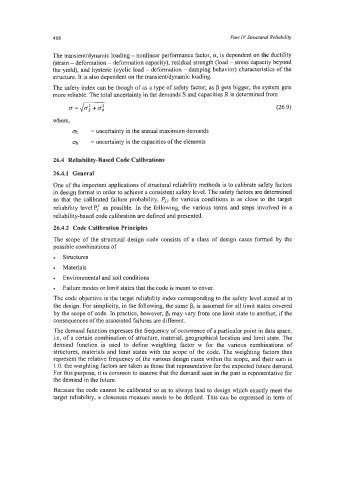Page 492 - Marine Structural Design
P. 492
468 Pari IVStructural Reliability
The transient/dynamic loading - nonlinear performance factor, a, is dependent on the ductility
(strain - deformation - deformation capacity), residual strength (load - stress capacity beyond
the yield), and hysteric (cyclic load - deformation - damping behavior) characteristics of the
structure. It is also dependent on the transientldynamic loading.
The safety index can be though of as a type of safety factor; as p gets bigger, the system gets
more reliable. The total uncertainty in the demands S and capacities R is determined from
a=Jm (26.9)
where,
os = uncertainty in the annual maximum demands
= uncertainty in the capacities of the elements
OR
26.4 Reliability-Based Code Calibrations
26.4.1 General
One of the important applications of structural reliability methods is to calibrate safety factors
in design format in order to achieve a consistent safety level. The safety factors are determined
so that the calibrated failure probability, PJ~ for various conditions is as close to the target
reliability levelP: as possible. In the following, the various terms and steps involved in a
reliability-based code calibration are defined and presented.
26.4.2 Code Calibration Principles
The scope of the structural design code consists of a class of design cases formed by the
possible combinations of
Structures
Materials
Environmental and soil conditions
Failure modes or limit states that the code is meant to cover.
The code objective is the target reliability index corresponding to the safety level aimed at in
the design. For simplicity, in the following, the same pt is assumed for all limit states covered
by the scope of code. In practice, however, pt may vary from one limit state to another, if the
consequences of the associated failures are different.
The demand function expresses the frequency of occurrence of a particular point in data space,
i.e, of a certain combination of structure, material, geographical location and limit state. The
demand function is used to define weighting factor w for the various combinations of
structures, materials and limit states with the scope of the code. The weighting factors thus
represent the relative frequency of the various design cases within the scope, and their sum is
1 .O. the weighting factors are taken as those that representative for the expected future demand.
For this purpose, it is common to assume that the demand seen in the past is representative for
the demand in the future.
Because the code cannot be calibrated so as to always lead to design which exactly meet the
target reliability, a closeness measure needs to be defined. This can be expressed in term of

